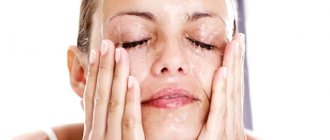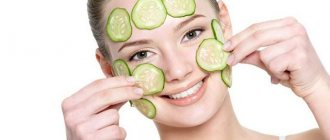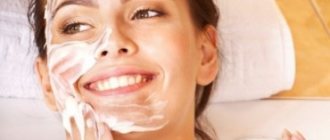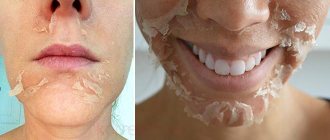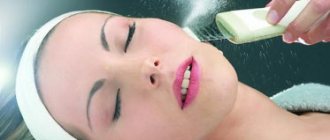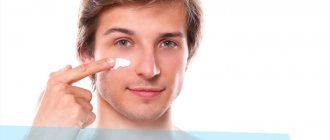Peeling is a method of cleansing and rejuvenating the face, stimulating the process of skin renewal by exfoliating the upper keratinized cells of the epidermis. The advantage of the procedure lies in the visible result and variety of types of peeling, which helps to effectively solve skin problems depending on its type and condition.
What adds to the popularity of peeling is the ability to carry out cleaning at home: giving your skin a radiant, fresh look is possible using affordable products and without wasting extra time. In addition to standard mechanical peelings from small abrasive particles (coffee grounds, salt, oatmeal) and base, you can also prepare chemical peeling at home, the components for which can be found in every pharmacy. One of the options for chemical peeling is the booming peeling ray, known in the USSR as “Skatochka” - peeling with calcium chloride.
The essence of the procedure
Calcium chloride peeling is a superficial type of chemical peeling and affects the skin in stages: first, the skin is damaged by a slight superficial burn, which causes the rejection of dead cells that have become ballast. In response to controlled inflammation and burn of the first layers of the epidermis, the regeneration process is launched, a protective mechanism for restoration and renewal of the skin.
The list of products for peeling with calcium chloride is ascetic; only baby soap and calcium chloride are required. The interaction reaction between the sodium and potassium salts of higher tricarboxylic acids contained in soap and the calcium salt of hydrochloric acid leads to the appearance of insoluble calcium salt from the higher carboxylic acid - “pellets”, which are mistakenly perceived as a removable layer of skin. The purpose of the pellets is to take away dead skin particles that are completely invisible to the human eye.
Cosmetic properties
- Exfoliating – removing dead cells, triggering subsequent effects.
- Anti-inflammatory – destruction and temporary suppression of the proliferation of pathogenic microorganisms that cause acne, pimples, and irritation.
- Whitening – smoothing skin color and getting rid of freckles and shallow age spots.
- Anti-aging – smoothing the relief and texture of the skin, eliminating fine wrinkles and activating collagen synthesis.
- Tightening - occurs due to the tightening of the skin by indelible sediment.
Use at home
Many girls, inspired by reviews on websites and videos from video bloggers, rush for the suddenly coveted ampoule of calcium chloride, quickly carry out manipulations and get an unexpected result or no result at all. Meanwhile, the detailed technology of the procedure includes nuances that allow peeling to be carried out with the best effect.
Purchase stage
- Only baby soap is used in peeling; only with it does the desired reaction occur.
- For the first peeling session, it is better to use a 5% calcium chloride solution, and approach 10% after a positive skin response to the drug; Those with dry skin can stop at 5%.
Preparation stage
- Cleanse skin of cosmetics and impurities.
- Wipe with tonic.
- Dry your face with a napkin; no moisture should remain on it.
- Protect the thin skin around the eyes by applying a rich cream to it, and hygienic lipstick to the lips.
Application stage
- Wipe your face with a cotton pad soaked in calcium chloride, avoiding the area around the eyes and lips. For combination skin types, peeling can only be performed on the T-zone (forehead, nose, chin).
- Wait until the liquid dries and apply the solution again.
- Repeat the cycle a couple more times. A total of 3-5 layers should be obtained: the more sensitive the skin, the less their number.
- Lather your fingertips until foam forms and massage your skin along the massage lines, stopping briefly in a certain area. If necessary, you need to add soap foam and continue gentle movements over the skin on which the pellets appear. It is more convenient to prepare the foam before it is time to apply it (for example, in the intervals between drying layers of calcium chloride); The less water in the foam, the better.
- After a characteristic squeak appears, rinse off the peeling with warm water.
For those who have already mastered the peeling algorithm well and want to speed up the procedure, there is a second, more gentle method of application. It is done in reverse order:
- A thick soap foam is prepared with a minimum water content in it. Then it is applied to the face.
- The fingertips are moistened in calcium chloride and rubbed along the massage lines of the face.
- The composition is removed when squeaks appear under the formed pellets.
Care stage
Cleansed skin is more receptive than ever to cosmetics: peeling prepares it for active absorption of moisturizing substances and enhances their effect.
Therefore, the correct skin care steps after a peeling session play a key role in maintaining its effects:
- After washing off the pellets, you need to let the skin dry naturally.
- Exfoliation destroys the skin's protective barrier and dehydrates it. The best way to moisturize the skin after peeling is a mask. Do not apply it immediately, allowing the skin to rest for 15 minutes.
Recipes
All exfoliation methods based on an aqueous solution of calcium chloride are based on its ability to interact with fatty acids, forming salts in the form of lumps that are rolled off the surface of the skin with your fingers.
Calcium chloride should not be applied around the eyes or above the upper lip.
After the session, the treated surface is sprayed with thermal water, a soothing mask is applied for 20-30 minutes, and then a moisturizer according to your skin type is applied.
For oily and combination dermis
This type is characterized by excessive sebum production. To exfoliate it you will need:
- calcium chloride ampoule;
- baby soap.
There is no need to degrease your face before the session; just rinse with water and dry with a towel.
Then perform the following sequence of actions:
- moisten a cotton pad with the solution;
- applied to the face;
- wait one minute;
- Apply another layer of calcium chloride.
A slight burning sensation may be felt. This means that the drug has begun to work.
Then the surface to be treated is covered with soap foam, immediately starting to massage with your fingertips along the lymph flow lines.
In this case, pale gray pellets form on the skin, resulting from the interaction of the product with skin fat and baby soap.
The massage is continued until the formation of lumps stops, rinse with cool water.
Facial peeling with calcium chloride and baby soap at home:
For normal
If the epidermis does not produce excess sebum, then peeling is carried out using a more delicate method.
The ingredients are used from the previous recipe, only the sequence of actions changes:
- the face is cleaned using a familiar product;
- Apply foam from baby soap to the surface and leave for 3 minutes.
Then, using fingertips or a brush, distribute the calcium chloride solution over the epidermis, starting to massage immediately, rolling off lumps.
After the formation of pellets stops, the mixture is washed off with plenty of cool water.
For dry
The epidermis, cleansed of makeup and impurities, is lubricated with a thin layer of cosmetic oil intended for dry skin types and left for 10 minutes.
Then apply two or three layers of 5% calcium chloride at intervals of 30 seconds
and begin to carefully roll. After finishing, wash off with plenty of cool water.
If the burning or tingling becomes noticeably painful, then the procedure should be stopped by washing off the drug first with water and then with emollient cosmetic milk.
For problematic
Problem skin should not be rubbed during peeling. This can lead to irritation and make the problem worse. A mask with cosmetic clay will help.
To prepare it you need to take:
- two ampoules of 5% calcium chloride;
- green clay in such quantity to form a paste that will be convenient to apply to the face.
The mixture is applied to problem areas after regular washing for 10-15 minutes.
Rinse off carefully, avoiding rubbing
This mask is especially effective for acne with whiteheads, which are formed as a result of clogged pores. The mixture draws out excess oil and toxins, allowing you to get rid of unsightly pimples very quickly.
You can use it once every five days until you get results. After the session, it is advisable to immediately wipe the problem areas with tonic and then lubricate them with moisturizer.
Universal soothing mask
For preparation you will need:
- oat flakes - 20 g;
- herbal decoction - 50 ml;
- cosmetic oil - 5 ml.
First, prepare a decoction from any suitable herb (mint, chamomile, calendula, sage, etc.), pour it over the flakes for 15 minutes, and drain off the excess liquid.
Oil is selected according to skin type: for oily, combination - grape seed, normal - peach, dry and sensitive - sesame, problematic - St. John's wort or calendula.
Mix the steamed flakes with oil and apply to the face after exfoliation with calcium chloride for 20-30 minutes.
If desired, you can add two drops of your favorite essential oil to the mask.
What peelings are there, how effective are they and what are they used for:
- What do you need to know about the procedure?
- Main types, how to choose them correctly?
- What time of year is best to do it?
- The effectiveness and benefits of this type of skin renewal.
- Rating of the best cosmetic cleansing products for the face and their cost.
Post-peeling masks
For a calming effect
Combine a teaspoon of crushed oatmeal, gruel of a third of a banana and 25 ml of herbal decoction/infusion (plants are selected depending on skin type, most often chamomile is taken). Leave the resulting mixture on the face for 10-15 minutes, preventing it from drying out. Wash off the mask with warm water, and then apply a cream suitable for the skin.
For anti-inflammatory effect
The components of this recipe are optimal only for oily skin types. Mix the base for the mask (banana, clay, etc.), a little baby powder with a couple of drops of tea tree essential oil and a decoction of herbs that have an anti-inflammatory effect. The duration of the mask is 10-15 minutes, after which it is washed off and the skin is lubricated with cream.
How often can the procedure be done?
The frequency of using calcium chloride for Hollywood facial cleansing will largely depend on the condition and type of skin. The product has a strong drying effect. Therefore, it is not recommended to use it too often.
People with oily skin types can cleanse once a week. It will help reduce the secretion of the sebaceous glands and significantly reduce pores.
If the skin is normal or problematic, peeling is done only 2 times a month. But you should abandon this option if inflammation, acne or redness appears on your face.
READ ALSO: Zinc ointment will get rid of wrinkles and acne
But if your skin is dry and sensitive, peeling is not advisable. In this case, it must be replaced with more gentle means. For example, an excellent effect can be obtained by using kefir, fresh lemon or tomato juice, sour berries and fruits.
results
People who have tested the effect of a simple chemical reaction experimentally most often enthusiastically describe the result of peeling and compare the result with the effect of an eraser.
In addition to the immediate transformation of the skin, the following benefits are noted::
- possibility of regular use;
- instant results that do not require a long recovery period;
- painlessness;
- absence of irritation and injuries that occur during mechanical cleaning;
Indications and contraindications
Peeling with calcium chloride can be used from the age of 14 to solve the following skin problems:
- Age-related changes - suitable for the first shallow, facial wrinkles and as a preventive measure.
- Photoaging (excessive UV radiation leading to changes in normal skin color, hyperpigmentation and increased manifestations of age-related changes).
- Pigmentation.
- Flabbiness or dullness of the skin.
- The presence of scars or scars.
- Problem skin (acne, post-acne, comedones, enlarged pores, acne).
- Excessive production of sebum.
- Thickening of the skin layer, which leads to uneven relief.
- Loss of elasticity, sagging skin.
- Dull skin color.
There are also contraindications for this chemical peeling:
- Contraindications due to skin conditions:
- dehydrated, sensitive skin;
- recent sunbathing, tanning;
- deep traumatic procedures performed less than 1.5 months ago (mesotherapy, deep cleaning, laser resurfacing);
- recent chemical or thermal burn;
- slow wound healing;
- severe rosacea;
- tendency to hypertrophic keloid scars;
- skin diseases during exacerbation (eczema, psoriasis, acne, dermatitis, etc.);
- small and large scratches, cuts, wounds;
- allergy to the drug.
- Contraindications due to the general condition of the body:
- colds;
- taking medications with photosensitizing effects;
- chronic disease in the acute stage;
- presence of cancer, radiotherapy;
- pregnancy and lactation;
- mental illness, especially epilepsy;
- diabetes;
- during menstruation;
- hypertonic disease.
It is not advisable to carry out cleaning if there is:
- multiple moles;
- hypertrichosis (excessive hair growth);
Peeling with calcium chloride
Chemical chloride peeling is a salon procedure that can be repeated at home. The cost is low, and as a result the skin is better renewed and cleansed. Under the influence of the peeling composition, the surface layer of the epidermis is removed, and the natural regeneration of the deep ones is accelerated.
To carry out the procedure at home you will need to take:
- Calcium chloride. A solution with a concentration of 5-10% is suitable for you. You can buy it at any pharmacy.
- Baby soap without fragrances or fragrances.
- The simplest cotton pads.
The procedure itself is also simple and does not require special skills.
But it requires care and caution - watch your skin’s reactions to the reagent. If negative manifestations are noted, do not perform the procedure again, choose a peeling with a different composition for yourself
Advantages and disadvantages
There are many positive effects from peeling. Among them:
- Renewal and deep cleansing of the skin.
- Lightening.
- Drying out small rashes.
The effect of cleaning is much more noticeable than with mechanical cleaning. Suitable for almost all skin types. Dry is the only exception. Even pre-moisturizing will not help; such peeling will only worsen the situation. This is the main disadvantage of this method of cleansing. It can also negatively affect your skin if you have problems with tolerating chemicals.
Contraindications
Before starting a chemical skin cleansing procedure, you should make sure that you do not belong to one of the groups of people for whom it is contraindicated. Chloride peeling should not be performed in the following cases:
- Dry skin.
- The presence of foci of inflammation, large or numerous pimples.
- Pregnancy, lactation period.
- Herpes and similar skin diseases.
- Individual intolerance.
- Increased sensitivity to chemical reagents.
If the above situations apply to you, you should choose a different method of cleansing your skin.
Precautionary measures
Allergy test
It’s worth forgetting about the glorious “maybe” and his friend “what will happen to me, a friend over there helped me” and test your luck in other situations. Ignoring basic precautions, a preliminary test on a small area of the body, can result in unpleasant consequences, including a burn on the face. As a rule, in negative reviews of the procedure and horror stories about the terrible consequences of peeling, the test is rarely mentioned.
In order not to detect individual intolerance to the drug after the fact, when treating irritations, it is enough to apply calcium chloride to a closed corner of the body, leave for 15-20 minutes and watch the skin reaction. Redness, itching, severe tingling are signs that it is better to postpone this type of peeling indefinitely.
If your face begins to burn after applying the solution, you don’t have to endure it through tears - the calcium chloride is carefully removed with dry wipes, your face is washed with soapy water and carefully blotted with a towel.
If after the first use of peeling your face remains red for a long time, you should consult a doctor and stop the peeling course.
Taboo on amateur performances
Strict adherence to all stages of peeling and recommendations for the procedure provides much more guarantees of a favorable result than attempts at independent creativity. Peeling with chemical components is not the territory of home cosmetology, where liberties and flights of fancy are permissible: no replacement of baby soap with antibacterial or natural soap; no additions of other cleansers to soap suds. And under no circumstances should you leave the components on the skin for a long period so that the peeling “cleans better.”
Harm from the procedure
The main argument of opponents of peeling with calcium chloride: the obsolescence of the method and the fact that the alkaline sediment formed on the skin is a medium for the development of pathogenic microorganisms. There is also the occurrence of irritation, increased dryness of the skin, and deprivation of its natural balance.
However, the mechanism of peeling itself is such that it dries out the skin, so it is incorrect to blame only a specific type of cleansing. The traumatic consequences of the procedure can be reduced with proper hydration after cleansing. It is also worth carefully monitoring the condition of the skin, reacting to the slightest changes and stopping the effects if the condition worsens.
Advantages and disadvantages of the procedure
Cleansing your face with calcium chloride and baby soap has its pros and cons. The advantages include :
- low price;
- availability;
- ease of the procedure;
- anti-aging, anti-inflammatory and whitening effects;
- cleaning and narrowing pores;
- high efficiency.
But in some cases the following disadvantages may appear :
- dry skin;
- risk of burns;
- the possibility of developing necrosis;
- pigmentation in summer;
- swelling;
- dermatitis;
- peeling.
All this harm can be minimized if the procedure is carried out according to all the rules, adhering to the advice of a cosmetologist.
Facial peeling using calcium chloride is otherwise called Hollywood cleansing. This is because the skin looks great even after one procedure.
Women note that their complexion becomes better, their texture is evened out and acne disappears.
However, in pursuit of beauty, it is worth remembering precautions . It is necessary to follow the instructions and carefully follow all instructions.
We described all the details and recommendations on how to cleanse your face with calcium chloride in this article.
Recommendations
- Evening is the optimal time for peeling. Overnight, the skin will have time to calm down: mild irritation will pass, and the components of the cream will be able to be fully absorbed.
- Peeling involves a course of procedures that are best performed in months with reduced solar activity, from October to April.
- The course of procedures is short, lasts 3 weeks, 1 procedure weekly. Then you should take a break for 2-3 months. If the skin is extremely thin and dry, the interval between procedures can be increased to 1 time per month.
- Basic oils have a beneficial effect on damaged, inflamed skin and therefore work in full force on a peeled face.
Post-peeling care
Post-peeling skin care does not end after applying the cream; it is very important to carefully take care of it in the future and help it recover. In the first 3-4 days, it is worth actively moisturizing the skin; the peeling process is still ongoing.
Peeling skin activates melanin production, which increases the risk of age spots. To prevent their appearance, the skin should be protected from direct sunlight and actively protected with creams with a high UV filter (from SPF30), especially when cleaning is carried out in the summer.
Peeling with calcium chloride is not a panacea for skin problems and has a number of limitations in use. Nevertheless, this decent budget product will cope with clogged/enlarged pores, refresh and even out the complexion. The main role in the successful outcome of the procedure is given to meticulous compliance with all rules and instructions.
Key rules for performing chemical peeling at home:
- Familiarize yourself with the list of contraindications and, no matter how itchy your hands, do not carry out manipulations during the period of exacerbation of skin diseases.
- Be sure to do an allergy test.
- Use only baby soap.
- Apply soap suds only to dried layers of calcium chloride.
- After peeling, moisturize and nourish the skin, pamper it more often with masks and oils.
- Protect your skin from the sun, use a cream with increased SPF.
Following these simple rules will prevent the negative effects of peeling and make your skin beautiful and healthy.
Why do you need peeling?
This excellent technique allows you to cleanse the skin of your face and body of dead cells. If the procedure is not followed, the pores become clogged and the ability to receive oxygen and absorb necessary substances, as well as various cosmetic masks when used, decreases. Facial cleansing with calcium chloride at home has been a popular procedure for a very long time, as it costs little money, and the result obtained lives up to all expectations.
The main actions of peeling are aimed at improving the health of the epidermis and its restoration. It often solves a problem such as blockage of the glands, and prevents this from happening again in the future, and also removes the stratum corneum, which causes various inflammations to the skin.




